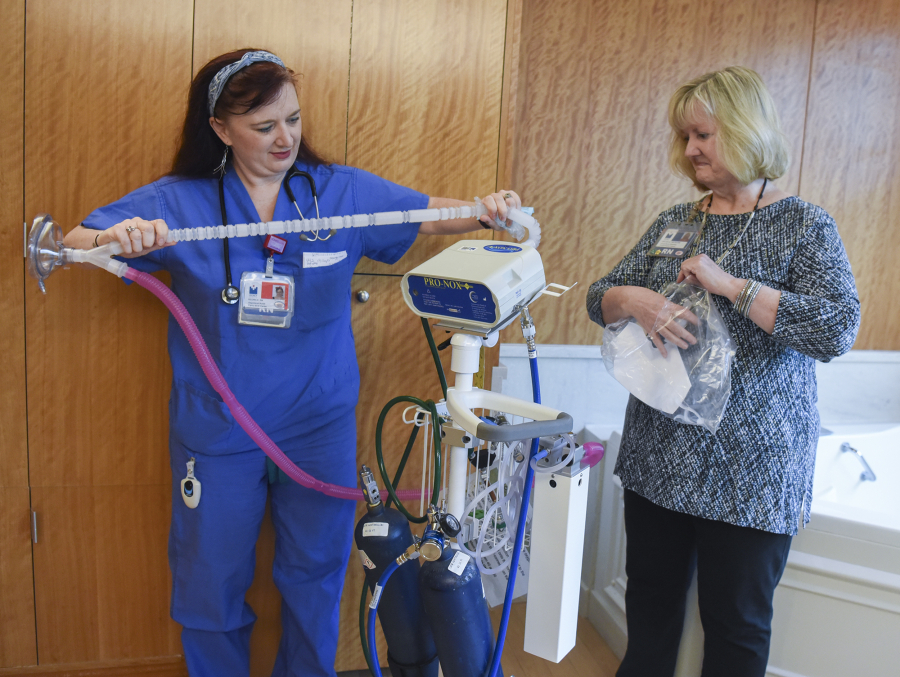Women in labor at Legacy Salmon Creek Medical Center can now find some relief from an unexpected source: laughing gas.
Last month, Legacy’s family birth center became the first in Southwest Washington to offer nitrous oxide to pregnant women in labor at the hospital. The nitrous oxide — which is a 50-50 mix with oxygen — can be used from the time the woman is admitted until the baby is born without any negative effects to mom or baby, said Shelora Mangan, clinical nurse specialist at Legacy Salmon Creek.
Unlike other labor pain relief options, such as IV fentanyl and epidurals, nitrous oxide leaves a woman’s system almost immediately without any lingering effects. The gas doesn’t metabolize in the liver — it’s cleared through the lungs — so it’s out of the woman’s system in 30 to 60 seconds, Mangan said.
“We have a lot of mommies who want to go natural,” said Ami Davis, the birth center’s nurse manager. “This is very non-invasive. It gives an extra option.”
So far, about two dozen women have used nitrous oxide during labor. Some have used it in lieu of other drugs, others have used it to prolong the need for an epidural. The nitrous oxide gives women the freedom to move around during labor, whereas an epidural means the woman is limited to her bed, Davis said.
The laughing gas is controlled by the woman and can be stopped or started at any time during labor. When a contraction begins, the woman brings the mask to her face and breathes in the gas. She controls how much gas is inhaled and when to stop. Within seconds of pulling the mask away, the effects of the gas are gone.
“It’s completely self-paced,” said Regina Kaiser, a registered nurse in the unit.
The gas is not free-flowing; the mask has to be up to the face and inhaled. That way, Mangan said, others in the room aren’t being exposed.
Kaiser has so far had three patients use nitrous oxide. One patient was experiencing anxiety as she prepared to be induced. Since she wasn’t dilated or having contractions yet, it wasn’t in her best interest to get an epidural. She tried the nitrous oxide and said it greatly reduced her anxiety, Kaiser said.
Some patients have also used the nitrous oxide to help calm their nerves and ease the pain of getting an epidural. Others have said the laughing gas helps them to feel in control and distract them from the pain of labor.
“It really isn’t pain relief,” Mangan said. “It’s that you don’t care that you’re in pain.”
Nitrous oxide was used historically in the United States for pain relief during labor. It was later replaced with other pain relief options but continued to be used in other countries. Several years ago, however, a teaching hospital began using it again and, since then, its use in the U.S. has grown, Mangan said.
“Now, it’s had a rebirth,” she said.
Other hospitals using the gas consistently report differing opinions among moms.
About 50 percent of women who use it love it; 30 percent don’t really like it and 20 percent absolutely hate it, Mangan said.
“The nice thing is it clears fast,” Davis said. So if a woman tries it and doesn’t like it, she can stop using it and get it out of her system immediately. The same isn’t true for IV narcotics and epidurals, she said.
Legacy Emanuel Medical Center began using nitrous oxide as a pilot project in November 2015. Its success led the health system to offer nitrous oxide at Legacy Good Samaritan and Legacy Mount Hood medical centers, and now, Legacy Salmon Creek.
Initially, some doctors in the community were a little apprehensive about the use of nitrous oxide during labor. Now that they’ve seen it being used successfully, without any negative effects, most doctors are on board and give the OK for their patients to use it, Kaiser said.
As an advocate of nitrous oxide, Kaiser hopes to see more of her patients take advantage of the option.
“I love it,” she said. “I absolutely love it.”




